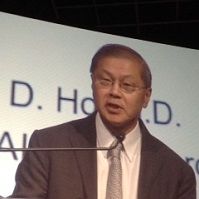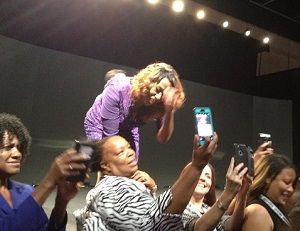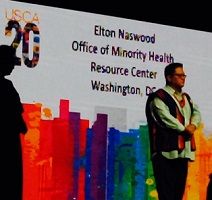Article
Good News, Nostalgia, Advocacy, and Science: the USCA Conference 2016 Opens
Author(s):
From showgirls to scientists, attendees at the 20th Annual US Conference on AIDS found much to celebrate and a lot left to be done in the quest to conquer HIV/AIDS.

There are AIDS memorial quilts on the walls of the main gathering hall at the United States Conference on AIDS, a research and advocacy congress that has drawn thousands to Hollywood FL for the event’s 20th Anniversary.
The wall hangings, all handmade personal commemorations of people who died of AIDS, look almost nostalgic in 2016, given the progress in AIDS research that in just two decades has turned the infection from a death sentence to a chronic ailment.

But the fight against AIDS, seen by many here as much as fight against discrimination for minority groups as one against a microbe, is still going on.
The event opened this morning with a plenary session and breakfast whose participants ranged from a pre-eminent scientist, David Ho, MD, wearing a dark suit, to a show-stopping Broadway singer, Dream Girls star Jennifer Holiday, in a glittering purple dress.
In between there were minority spokespeople from a rainbow of coalitions, from Native Americans, to Transgender Los Angelinos, AIDS groups from both coasts and beyond. Two sign language specialists interpreted it all for the death, and a Spanish language translation service provided simultaneous explanation as well.
Underwriting much of the event were pharma sponsors intent on seeing their drugs for Pre-Exposure Prophylaxis gain wider use and become the latest milestone in the fight against the deadly virus.
After a poignant photo montage tribute to mostly gay and transgender victims of the Orlando nightclub shooting earlier this year, Holiday took the stage.
She said she has been an AIDS activist since the early days of the epidemic began taking the lives of those she knew from the cast of Dream Girls, she said.
“All of them gone,” she recalled, speaking of several people who worked behind the scenes on the musical, recalling days when there was news every day of another friend lost to the virus.
Each panelist lit a candle in tribute to those lost to AIDS and the consequences of discrimination.

“As we release doves in the spirit of love, we light these candles,” Holiday (photo, right with admirers) said.

Panelist Elton Naswood, a Navajo tribal member who now lives near Washington DC where he works at the NIH’s Office of Minority Health Resource Center, said much work needs to be done to help people who are Native Americans and Alaskan Native Peoples. He began his talk by thanking the Seminole Tribes of Florida “for allowing me to be here.” He went on to talk about the problems Native Americans face with AIDS and HIV.
Between 2014 and 2015 there was a 19% increase in new AIDS infections in those communities, Naswood said (photo, left).
“We are the population that doesn’t count,” he said, pointing to a button on his Navajo vest that pictured a slash through the word “count.”
AIDS remains “a form of genocide” he said, particularly in this “interesting time in America politically and socially.”
“Our struggle continues,” he said.
Speaker Bamby Salcedo, a Transgender Activist from Los Angeles, CA, opened her remarks with a callout to transgender people or others who are “gender non-conforming” to come to the stage. About a dozen people did. At her urging, each took the microphone and all described themselves as leaders, part of new wave of activism.
The session closed with a science lesson and message of hope after Evelyn Ullah introduced David Ho, the Time Magazine Man of the Year in 1996.
He was the USAC’s first keynote speaker, at its initial meeting in the same venue, 20 years ago.
“He is a bold, brave, courageous leader,” she said, “As a nurse I was thinking then that here is a physician who subdued a public scare, taught people that there is not sufficient HIV in saliva that you could get it from drinking glasses or a kiss.”
She continued, “He gave us hope for the first time, he created a biomedical prevention agenda.”
Ho’s speech began with a simplified lecture on protease inhibitors, and segued into the science of pre-exposure prophylaxis (PrEP).
“1996 was a turning point in the epidemic,” Ho recalled, and when he addressed the USCA 20 years ago, “I talked about the new results from combination therapies.”
Those drugs were to become the AIDS cocktails that have kept patients alive ever since.
“This morning I’ll move on to talk about new strategies,” he said, and launched into a summary of research on the latest PrEP drugs.
“We have control, but not a cure,” he said, “We put out the raging fires but we cannot eliminate that ember.”
There are 17 million people worldwide now getting therapy, and get 2.1 million new HIV infections are found daily and 58% of those with the virus are not getting treatment.”
That makes prevention all the more important, and he praised the audience for the work many are doing daily. Drugs also have a big role to play, Ho said, and PrEP with tenofovir (Truvada) has been shown to work in up to 80% in some studies while only 40% in others.
“Why the variability? The answer is simple, the drugs work but human behavior is lacking.”
In addition to tenofovir, which is a daily pill, Ho and colleagues at Aaron Diamond AIDS research are working on a new drug that could be taken as an injection every two months.
"My hope is that at a future USCA conference we will be talking about the high protective efficacy of such a strategy," Ho said.




